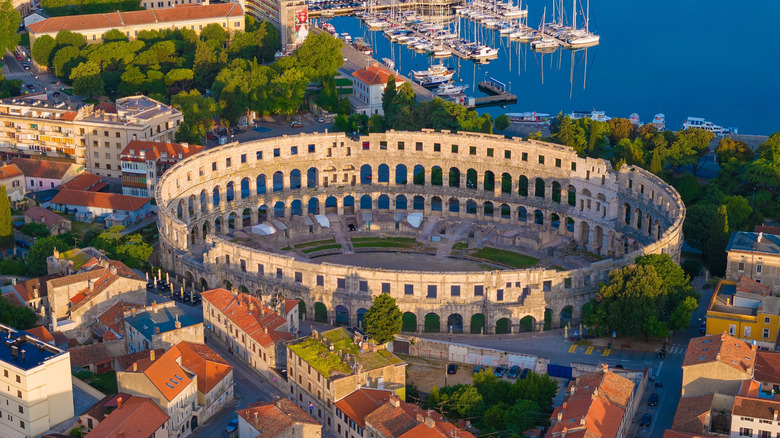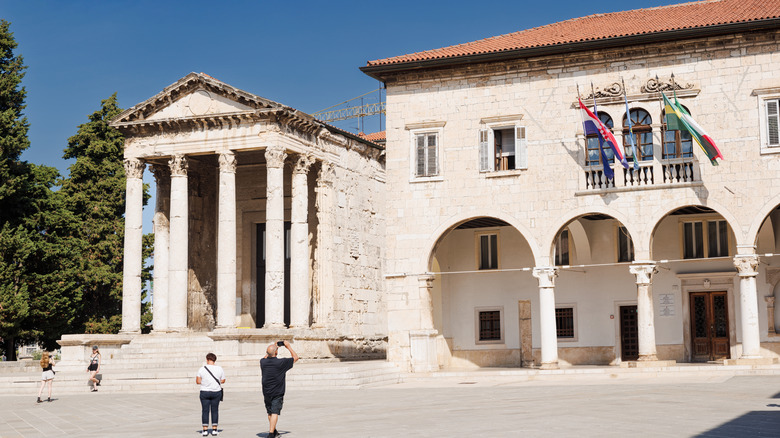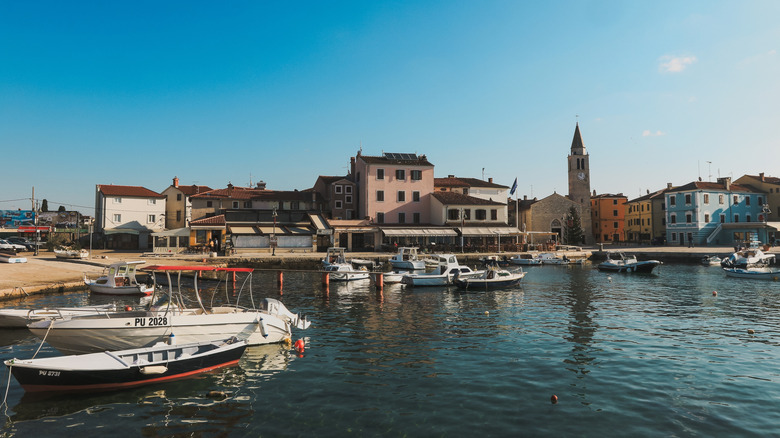Croatia's Breathtaking City With Ancient Ruins Is Like A Miniature Rome With Fishing And Beaches
Surrounded by five countries and shaped by powerful domains, Croatia is a Central European nation that has embraced different traditions while emerging as an independent country with its own unique identity. What Croatia may lack in size, it more than makes up for in cultural heritage, spectacular coastlines, and picturesque towns. Located about 122 miles from the capital, Zagreb, the city of Pula offers a fascinating alternative to the hustle and bustle of destinations like Rome, thanks to its enduring Roman legacy. Pula beckons tourists with its pristine beaches — a perfect location for starting your island hopping in Croatia — and a bustling fishing hub that enriches the local cuisine. Nestled at the southern end of the Istrian Peninsula, Pula has its own airport and can be reached by plane from Zagreb. If you're traveling from Italy by car, it's an under 2-hour drive from Trieste.
Often overshadowed by some of Croatia's most famous beaches, like those in Dubrovnik, this underrated city offers an ideal setting for water activities, such as boat trips, kayaking, and jet skiing. Its Adriatic-washed shores have been awarded the Blue Flag for their purity and quality.
One of the most popular beaches is Saccorgiana Beach, a family-friendly gravel beach where people can sunbathe on the grass or swim in its calm waters. Histria, with its half-pebble and half-concrete shoreline, is another great option for families. Thanks to the trees fringing the area, the beach is well-shaded and offers direct access to the sea. If you want to be more active, there's a sports center next to Valkane Beach — a blend of rock, pebbled sections, and paved waterfronts, with facilities that provide wheelchair access. Among the most popular Blue Flag beaches for families, Ambrela Beach attracts tourists with its turquoise waters and pebbly shores. It's an ideal location for its amenities, such as public toilets, cabins, and nearby eateries.
Explore Roman history in Pula
As you walk through Pula, you might imagine echoes of applause lingering in the air and a hum of excitement in every corner. Steeped in Roman history, Pula's architecture still reflects the grandeur of that ancient era, and the town is home to the world's only Roman arena featuring an intact circular wall. The Pula Arena, or Amphitheatre of Pula, is the crown jewel of the town. Built between the reign of Emperor Augustus and concluded under Vespasian, this smaller colosseum is a must-see. The building once entertained crowds of around 20,000 people with gladiator battles and other shows, and it still preserves a hidden underground that held animals and gladiators before their appearances. Today, the Pula Arena still hosts a variety of cultural events — far less cruel than those games.
Head to Pula's Forum — the town's historical central square — and you'll find the Temple of Augustus. The temple was dedicated to the goddess Roma and Augustus, and its construction started when the emperor died. Once the heart of social and political life in Pula, today it's a museum showcasing sculptures and other antiquities. Just a seven-minute walk from the temple, you'll come across the Arch of the Sergii. Built to honor three Sergius brothers, it once served as a gateway to the city; now, it guides visitors toward the old town.
To continue your journey through Roman history, visit Cave Romane — an old Roman quarry where stones were once extracted to build the Pula Arena. Today, you can explore the site and enjoy open-air music. Then, stop by Agrippina's house, a 3,000-year-old building where a bust of Agrippina Minor still stands. There, you'll discover traces left by Venetian influences, as well as artifacts from Etruscan and Hellenistic times.
Go fishing in Pula
Fishing is not just a sport in Pula; it's also a vital part of its heritage. Dating back to Roman and Greek times, fishing provided settlers with a reliable source of food. Today, thanks to Pula's rich marine life, locals and tourists can venture out to catch a variety of fish, such as sea bass, squid, tuna, and many others. If you prefer to stay near the shores, try shore fishing while soaking up the sun and admiring the landscape. But if you're determined to catch some bigger fish, hop on a boat and head out to greater depths. You can also bring your own gear to avoid renting any equipment.
Big Game fishing is a popular activity in Pula, which offers the perfect location on the Istrian peninsula to catch bluefin tuna — above all — from September to November when the fish approach the coast. Several fishing charters provide trips teaching you the techniques for a successful catch. Otherwise, opt for spearfishing on a guided tour. To avoid disappointment, be sure to obtain your fishing license through a tourist office if you're older than 14. You can take advantage of this year-round activity thanks to the Mediterranean climate.
Enjoying a tasty fish dinner in Pula will be your cherry on top. Head to Veritas Food & Wine to savor local dishes and wines, or visit Vodnjanka, where they serve traditional Istrian food along with their signature herbal brandy aperitif. Reserve a table at the Michelin-starred Konoba Batelina, located in Banjole, south of Pula. This family-run restaurant, operated by fishermen, had the pleasure of hosting and dining with Anthony Bourdain when he visited Croatia for his series "No Reservations."


